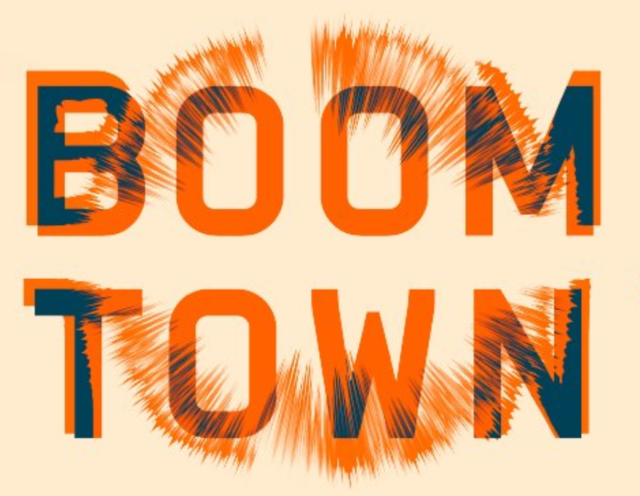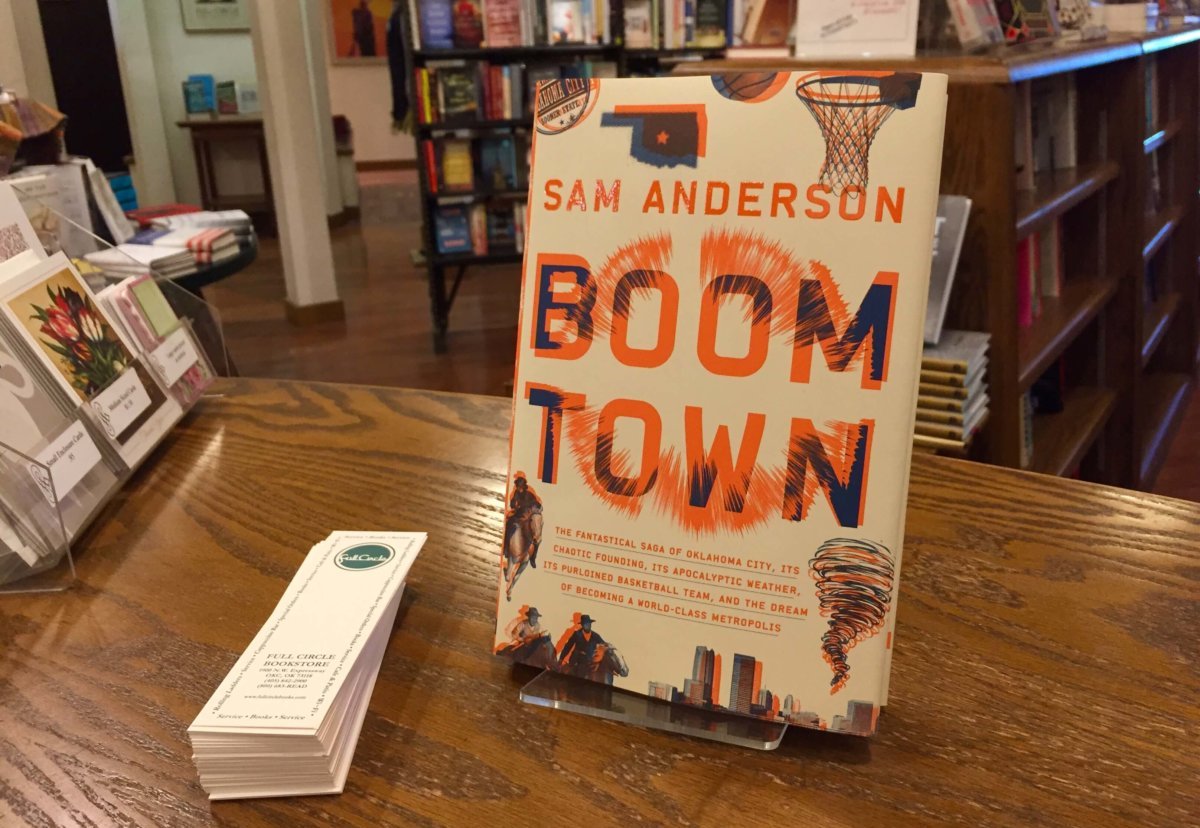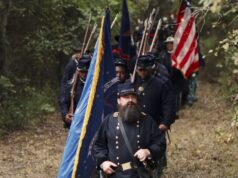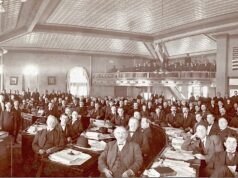The battle between chaos and control in Oklahoma City constitutes the main theme in Sam Anderson’s new book, Boom Town. As is true of Oklahoma as a whole, a cycle of booms and busts has dominated OKC. It has also been dominated by a small elite circle of businessmen, once led by E.K. Gaylord (“the most powerful man in the city”), who, until his death in 1974, owned the newspaper formerly known as The Daily Oklahoman, and the Chamber of Commerce’s Stanley Draper, who died in 1976 but “invisibly shaped” the city’s development.
Anderson is an awesome prose stylist who anchors the city’s 130-year roller coaster ride on just over a year of the Thunder NBA basketball team’s ups and downs. With one exception – the failure to tackle Gaylord’s role in running the city – Anderson does a great job of weaving together diverse historical topics, such as:
- the 1889 Land Run, i.e. the “Clusterfuck on the Prairie”;
- oil booms and busts;
- Jim Crow segregation, Clara Luper, the sit-in movement and the sanitation strike of 1969;
- and the antithesis to his approach: the democratic and process-oriented MAPS urban development process and the creative culture it spurred.
There is a tension between Anderson’s goal of humorously celebrating Oklahoma City as “one of the great weirdo cities of the world” and reporting some of the darker sides of “… its excesses, its imbalances, its illusions, its overcorrections, its lunges of pride and insecurity, its tragedies, and its improbable achievements.” There is also a tension between his desire to say “… something deeper about the nature of cities about human togetherness” and the space I would have liked him to devote to the damage done by Oklahoma City’s most ruthless power brokers.
‘Chaos’ versus ‘forces of order’
This tension is demonstrated by the contrast between the first paragraph of the blurb on front cover and the precise words Anderson uses when telling our history. It begins, “Oklahoma City was born from chaos. It was founded in the bizarre but momentous Land Run of 1889 …”. The blurb foreshadows how “… it has been a city torn between the wild energy that drives its outsize ambitions and the forces of order that seek sustainable progress.”
RELATED
Boom Town ‘the best advertising’ OKC has ever known by William W. Savage Jr.
Anderson soon acknowledges, however, that the so-called “forces of order,” led by Gaylord, Draper and a handful of chamber leaders, focused on their self-interests. Their “outsize ambitions” gave “Oklahoma City a national reputation for the ravenous snatching of everything worth having: money, publicity, projects, land.” Anderson writes that Draper was a “hyperaggressive booster” who sought to replace “official government” because it “was too constrained, too visible, its power was dispersed across too many people, most of whom were subject to the silly popularity contests of elections.”
Although he leaves it to one of Draper’s contemporaries to describe him as “quasi-fascist,” Anderson describes Draper’s backroom efforts to expand “the chamber’s proper zone of control” to an “infinite” level, involving “everything which makes life more livable.” He quotes a speech in which Draper said, “The properly organized Chamber of Commerce is the best compromise possible between the principles of democracy and those of a benevolent aristocracy.” This is because the Chamber’s leaders “were exempt from ‘the disorderly and violent processes of our elections.’”
Prevailing dogma in OKC’s early days: ‘What is being done is good’
Anderson also cites public documents to reveal the true values of these backroom power brokers. The city’s 1930 comprehensive plan:
Oklahoma City is primarily a city of native born white Americans. … The principal racial problem centers about the Negroes. They are a necessary and useful element in the population and proper provision should be made for their living facilities. While it is an advantage of each race that living areas be segregated, the white race should be much interested in the welfare of the Negroes because of close contact resulting from the employment of Negroes as servants in various capacities.
Describing the ill-fated “Great Annexation,” where the city grew to nearly 600 square miles, Anderson followed the same approach when he cites an anonymous article in The Daily Oklahoman that reads as if Draper had written it. He noted the commonly heard Draper talking points while recalling a quote by an “anonymous developer, who sounded like a fascist hypnotist: ‘Everyone needs to understand and accept the belief that what is being done is good.’”
Given the hard-hitting quality of the quote, maybe I shouldn’t complain about the quantity of such straight talk.
Anderson said that the Great Annexation was good for oilmen, developers, car dealers, malls and their consumers, but it was also “unclear that it was good for Oklahoma City at large.” During a book signing, however, he made it clear that the land grab was disastrous. Boom Town is equally careful in describing the great damage done by the way Oklahoma City implemented urban renewal and the Pei Plan as well as the 1980s oil boom and bust.
Maybe it is unfair to expect even more historical analysis in a book that was inspired by controversies over the Thunder’s James Harden and Kevin Durant. I’m worried, however, that readers will be more distressed by the destruction of aesthetically beautiful buildings and the loss of basketball games than the lives of poor and working people who were wrecked by what Anderson describes as the elites’ “self-inflicted disappointments.”
There may be an unexpected problem with stressing the way that Draper et al. were “crazily ambitious” while failing to address whether their interlocking trusts and secret strategies were likely to be not only illegal but also antithetical to the principles of government of, by and for the people. At minimum, that imbalance makes it more difficult to appreciate Anderson’s descriptions of MAPS as the opposite of a “Draper scheme.” The 1990s development plan “… would be initiated through official government channels and approved by a formal vote.” It was an openly planned process, and I would argue that, whether you agree or disagree with MAPS priorities and decisions, it illustrates why democracy is better than the Gaylord-Draper power grabs.
In an understated way, Anderson illuminates the ways that today’s leaders are similar and different that those of the Gaylord-Draper era. Even in the 21st century, he writes, city leaders exhibited the “… rollicking confidence of men who believed they would never be subpoenaed.”
Our democracy will continue to make mistakes
Anderson agrees that in the case of the Thunder, Oklahoma City’s commitment to big projects has had a positive trickle -down effect. He gives us both sides of the arguments between engineers such as City Manager Jim Couch and city planners like Russell Claus over the building of roads instead of placemaking. He explains why the city could be more like Seattle if so many beautiful downtown buildings had not been demolished, and then he leaves us with three epilogues. Just as the Thunder have struggled, the current boom could be undermined by the same “mistakes” that occurred during our first century.
Anderson chose the book he wanted to write and did a great job. I wish he had explored the differences between today’s mistakes made in secret and the secret crimes of the past. Maybe he’s correct to focus on transparency as opposed to the letter of the law. Our democracy will continue to make mistakes, but if we have open conversations about our past, maybe there will be no need for a volume two: The 21st Century Boom and Bust Town.























